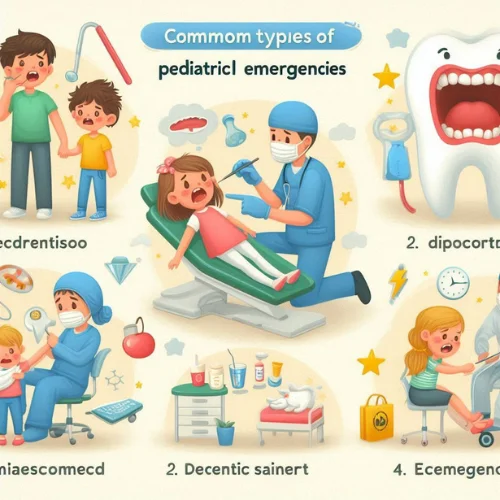What Should Parents Do If Their Child Experiences a Dental Emergency?

|
Getting your Trinity Audio player ready...
|
Dental emergencies can happen anytime — during a soccer game, while eating lunch, or even at bedtime. As a parent, it’s easy to panic when your child is in pain or bleeding from the mouth. Knowing what to do in the first few minutes can make a big difference in your child’s comfort and dental health. In this guide, we’ll explain exactly what parents should do if their child experiences a dental emergency and how to prevent future issues.
Understanding a Dental Emergency

A dental emergency involves any injury or condition in the mouth that causes severe pain, bleeding, or risk of permanent damage. It’s not just a chipped tooth — it can include lost teeth, infections, or trauma to the jaw or soft tissue.
Common Types of Pediatric Dental Emergencies

- Knocked-out tooth (avulsion)
- Cracked or fractured tooth
- Severe toothache or abscess
- Bitten tongue or lip
- Object stuck between teeth
- Broken braces or wires
First Aid for Pediatric Dental Emergencies

Quick action can reduce pain and help save a tooth. Here’s what to do for some of the most common emergencies:
1. Knocked-Out Permanent Tooth
- Stay calm. Reassure your child and keep them still.
- Find the tooth. Hold it by the crown (top), not the root.
- Rinse gently with clean water if dirty.
- Try to reinsert the tooth into the socket if possible.
- If not, store in milk or saliva and get to the dentist within 30 minutes.
2. Chipped or Broken Tooth
- Rinse the mouth with warm water.
- Apply a cold compress to reduce swelling.
- Save any broken pieces if you find them.
- Contact your child’s dentist as soon as possible.
3. Severe Toothache
- Rinse with warm salt water.
- Check for food stuck between teeth and gently floss.
- Use a cold compress for pain relief.
- Do not apply aspirin directly to the gums.
- Call a dentist immediately.
4. Soft Tissue Injuries (Tongue, Lip, Cheek)
- Clean the area gently with water.
- Apply pressure with a clean cloth or gauze to stop bleeding.
- Use a cold compress to minimize swelling.
- Seek medical care if bleeding doesn’t stop after 10 minutes.
5. Object Stuck Between Teeth
- Try using dental floss to remove the object.
- Never use sharp tools like pins or needles.
- If it doesn’t come out, contact your dentist.
When Should You Go to the Emergency Room?
Most dental emergencies should be handled by a pediatric dentist, but some situations require a trip to the emergency room, such as:
- Uncontrollable bleeding
- Broken jaw or facial bone
- Severe infection with fever or swelling around the eye
- Difficulty breathing or swallowing
Dental Emergency vs. Routine Dental Problem
Understanding the difference helps you take the right steps.
| Condition | Dental Emergency | Routine Issue |
|---|---|---|
| Knocked-out tooth | Yes | No |
| Mild toothache | No | Yes |
| Swollen gums with fever | Yes | No |
| Lost filling | No | Yes |
| Chipped tooth (no pain) | No | Yes |
Pros and Cons of Immediate Dental Treatment
Pros
- Faster pain relief for your child
- Greater chance of saving a tooth
- Lower risk of infection
- Avoid long-term complications
Cons
- May be expensive without insurance
- Limited access to pediatric dentists after hours
- Stressful for the child in emergency situations
How to Prevent Dental Emergencies in Children
While some accidents are unavoidable, many dental emergencies can be prevented with simple steps.
1. Use Protective Gear
- Always have your child wear a mouthguard during sports.
- Use helmets when biking, skating, or climbing.
2. Practice Good Oral Hygiene
- Brush twice a day and floss daily.
- Visit the dentist for checkups every six months.
- Address cavities early before they become painful.
3. Watch Eating Habits
- Avoid hard foods like ice, popcorn kernels, or hard candy.
- Cut food into smaller pieces to prevent choking or damage to teeth.
4. Childproof Your Home
- Use corner protectors on furniture.
- Keep sharp or hard objects out of reach of toddlers.
Emergency Dental Kit: What Every Parent Should Have
Prepare a small kit at home or in your car with:
- Gauze and cotton balls
- Small container with a lid (to hold a tooth)
- Cold compress or instant ice pack
- Saline solution or water
- Contact info for your pediatric dentist
- Gloves and a small flashlight
FAQ: What Should Parents Do If Their Child Experiences a Dental Emergency?
What is the most common dental emergency in children?
Knocked-out teeth and toothaches are among the most common pediatric dental emergencies.
Should I take my child to the ER or the dentist?
If there’s severe bleeding, swelling, or trauma to the face, go to the ER. Otherwise, contact your dentist first.
Can baby teeth be reinserted if knocked out?
No. Baby teeth are not re-implanted. Still, you should visit a dentist to check for damage and ensure proper healing.
What should I do if my child’s braces break?
Call the orthodontist. Use wax to cover sharp wires. If a piece breaks off, save it and bring it to the appointment.
How soon should my child see a dentist after an emergency?
Immediately — ideally within 30 minutes to one hour for knocked-out teeth or severe pain.
Conclusion: Be Prepared, Stay Calm, Act Quickly
Dental emergencies can be scary for both parents and children. But knowing what to do when your child experiences a dental emergency can protect their health and ease their pain. Keep emergency supplies on hand, stay calm under pressure, and always reach out to a pediatric dentist as soon as possible.
Don’t wait for an emergency to happen. Save your dentist’s number today and talk to your child about dental safety — a few minutes of preparation can make all the difference.






